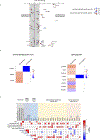Early antiretroviral therapy-treated perinatally HIV-infected seronegative children demonstrate distinct long-term persistence of HIV-specific T-cell and B-cell memory
- PMID: 32167989
- PMCID: PMC7531185
- DOI: 10.1097/QAD.0000000000002485
Early antiretroviral therapy-treated perinatally HIV-infected seronegative children demonstrate distinct long-term persistence of HIV-specific T-cell and B-cell memory
Abstract
Objective: To investigate long-term persistence of HIV-specific lymphocyte immunity in perinatally HIV-infected children treated within the first year of life.
Design: Twenty perinatally HIV-infected children who received ART therapy within the first year of life (early treated) and with stable viral control (>5 years) were grouped according to their serological response to HIV.
Methods: Western blot analysis and ELISA defined 14 HIV-seropositive and six seronegative patients. Frequencies of gp140-specific T-cell and B-cell, and T-cell cytokine production were quantified by flow cytometry in both seronegatives and seropositives. Transcriptional signatures in purified gp140-specific B-cell subsets, in response to in-vitro stimulation with HIV peptides was evaluated by multiplex RT-PCR.
Results: Gp140-specific T cells and B cells persist at similar levels in both groups. A higher production of IL-21 in gp140-specific T cells was found in seropositives vs. seronegatives (P = 0.003). Gene expression in switched IgM-IgD- gp140-specific memory B cells after stimulation with HIV peptides in vitro demonstrated a differential expression of genes involved in signal transduction and activation after BCR/TLR triggering and B-cell activation. Genes relating to antibody production (PRDM1) and T-B cognate stimulation (CXCR4, IL21R) were differentially induced after in-vitro stimulation in seronegatives vs. seropositives suggesting a truncated process of B-cell maturation.
Conclusion: HIV-specific memory B and T cells persist in early treated regardless their serological status. Seronegatives and seropositives are distinguished by gp140-specific T-cell function and by distinct transcriptional signatures of gp140-specific B cells after in-vitro stimulation, presumably because of a different antigen exposure. Such qualitative insights may inform future immunotherapeutic interventions.
Conflict of interest statement
CONFLICT OF INTEREST
The authors have declared that no conflict of interest exists.
Figures




References
-
- Luzuriaga K Early Combination Antiretroviral Therapy Limits HIV-1 Persistence in Children. Annu Rev Med 2016,67:201–213. - PubMed
-
- Ananworanich J, Puthanakit T, Suntarattiwong P, Chokephaibulkit K, Kerr SJ, Fromentin R, et al. Reduced markers of HIV persistence and restricted HIV-specific immune responses after early antiretroviral therapy in children. AIDS 2014,28:1015–1020. - PubMed
Publication types
MeSH terms
Substances
Grants and funding
LinkOut - more resources
Full Text Sources
Medical

